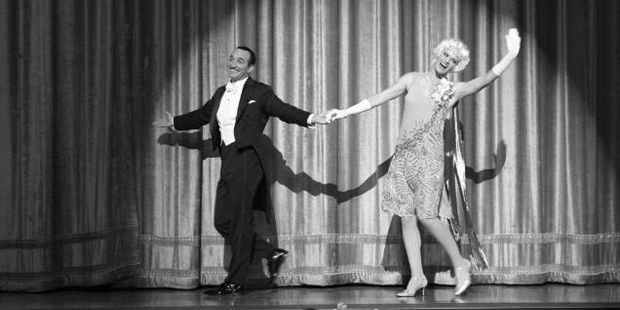A sense of longing for the past or nostalgia towards our cultural history has long since been used as a yardstick for contemporary filmmaking. Today, this trend hasn’t changed. Whether it’s in biopics (J. Edgar, Tatsumi, Dreams of a Life), documentaries (Magic Trip, The Black Power Mixtape, Tabloid) or period features (The Deep Blue Sea, The Awakening) we’re always at it.
Award nods, rave reviews and whispers in the box office queue have characterised much of the hype surrounding Michel Hazanavicius’s The Artist. It appears on our screens as the ultimate celebration of history; a silent movie which has been shaped and chiselled away at so it can slip into modern cinema like a jigsaw piece. But does it represent our love of history and of filmmaking itself, how the forms shifted throughout the years and how we may rejoice in the roots of our now dialogue-based art form? Or does it refresh an older mode of cinema specifically for the modern screen, neither yearning for nor idolising the past, instead commenting on the need for renewed styles which can kick-start stagnant processes and a uniform mise-en-scène?
In a way, to reveal the intricacies of what goes on in The Artist is to spoil the nuanced genius at the root of the filmmaking, so we’ll keep it broad. Set amongst the hustle and bustle of the Roaring Twenties, the plot follows silent movie star George Valentin (Jean Dujardin), revered by the press, adored by his female followers and envied by actors. With the introduction of the talkies however, Valentin’s fame slips away into anonymity, his sense of hubris and success lost in the wind, as he attempts to claw back an industry which has seemingly moved on. His opposite in the talkies is Peppy Miller (Bérénice Bejo), a spritely youngster who, after learning some tricks of the trade from Valentin, is swept up in the rolling intensity of the new genre.
At its most basic form, The Artist is a parody of the old vs. new, youth vs. maturity, arthouse vs. populism debates. From conception to conclusion, the silent film era spanned successfully for the best part of 25 years, borne largely out of practical limitation in the fusion of image and sound on screen. The advent of synchronised sound in cinema was simply a technological advance, and much as it reflects our desire to progress, signified a natural transition from silent film into the sound era.
The Artist uses this to defend the nature of the silent film, how dialogue can mislead, spoil or alter the essence of the image or the symbol. They play a large part in the film itself; Valentin often poses for photographs, the behind-the-scenes of his movies feature more than the films themselves, and lingering shots of buildings, streets and shop-fronts define the cultural and iconographic significance of the industry boom. What Hazanavicius refreshes in the film is how these symbols are portrayed – surrealism and absurdism are employed as tactical aesthetic devices; when Valentin talks to a smaller version of himself, or talks to his shadow, it provides an edginess owed to the computer age of cinema yet gives life to an era before CGI and “special” effects. This, along with the conversation the film has on evolving forms of cinema, assigns an intellectual discourse to the film on how evolution is natural but its results may seem unnatural.
There is a danger hidden within The Artist however in which the film may simply overuse new styles. While surrealism and absurdism add to the humour and sense of parody, they risk jarring against the lucid and elegant presentation of the film’s ideas. It’s a balancing act which Hazanavicius orchestrates with slight mastery, never quite dropping off into obscurity but constantly deviating from convention. Not only is this fascinating to watch as cinema-goers, it opens doors to the power of modern cinema in its ability to tackle the old. Our current cinematic zeitgeist can get a lot of stick; over-produced science fiction movies, 3D indulgences and deadend rom-coms characterise a large portion of the market today, yet Hazanavicius shows that we still have the capacity to rouse and excite audiences with modern paradigms.
It slips The Artist, in part, into meta-cinema. The film is about making films, how the industry itself produces its classics and how it deals with popular demand, technological advance, and how it adapts to the needs of society. A lot of the action takes place on the set of Valentin’s movies, but not on camera; only we are privy to the off-stage antics of Valentin and the other characters, a voyeurism which isn’t uncomfortable but intriguing. This experience then becomes altogether different from Valentin’s audiences in the film who are engaged in the cutting edge, the popular, the successful. We approach the genre with hindsight, with modern prescriptive values on cinema which don’t seem applicable to silent film – yet Hazanavicius has turned these judgments against us by suggesting we do owe something to history, we owe that sense of progression, the roots of our judgments arcing from primary populism to cult value.
Much then as our values are adaptable, ultimately so too is cinema, whether it evolves taking with it the essence of what is desired on screen or whether it can be re-introduced at any point. Not only should the silent era genre be celebrated today, The Artist should be accepted into both old and new cinema, its fluidity teaching us much on the compartmentalisation of genres and styles. Good cinema should not entertain the idea of demarcation; it should fight to occupy as many divisions as possible to keep the industry fresh and the viewer in debate. The Artist does this. Thankfully, it deserves its hype. While it’s hard to predict how the cinematic calendar will play out in 2012, the industry will have to go some distance to vault the bar which has been set remarkably high.

